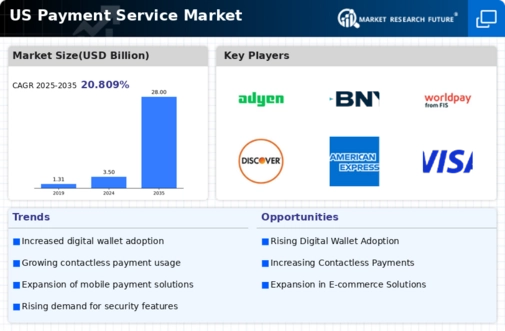Growing E-commerce Sector
The expansion of the e-commerce sector is a pivotal driver for the payment service market. As online shopping continues to gain traction, consumers are demanding seamless and secure payment options. In 2025, e-commerce sales in the US are projected to surpass $1 trillion, significantly impacting the payment service market. This growth necessitates the development of diverse payment solutions, including digital wallets and buy-now-pay-later options, to cater to varying consumer preferences. Consequently, businesses are compelled to enhance their payment processing capabilities, thereby fostering innovation and competition within the payment service market.
Increased Mobile Payment Adoption
The surge in mobile payment adoption is a significant driver for the payment service market. With the proliferation of smartphones, consumers are increasingly utilizing mobile payment applications for their transactions. In 2025, mobile payment transactions in the US are anticipated to exceed $500 billion, reflecting a growing preference for convenience and speed. This trend is prompting businesses to integrate mobile payment solutions into their operations, thereby enhancing customer engagement and satisfaction. As the payment service market evolves, the emphasis on mobile payment capabilities is likely to intensify, leading to further innovations and competitive advantages for early adopters.
Regulatory Changes and Compliance
Regulatory changes are influencing the payment service market, as businesses must adapt to new compliance requirements. The implementation of regulations such as the Payment Card Industry Data Security Standard (PCI DSS) and the General Data Protection Regulation (GDPR) has heightened the focus on data security and consumer protection. In 2025, compliance costs are expected to rise, prompting companies to invest in secure payment solutions. This shift is likely to drive growth in the payment service market, as organizations seek to ensure compliance while maintaining customer trust and loyalty. Adapting to these regulations may also lead to the development of innovative payment technologies.
Consumer Demand for Enhanced Payment Options
Consumer demand for diverse and flexible payment options is reshaping the payment service market. As preferences evolve, customers are seeking alternatives beyond traditional credit and debit cards. In 2025, it is projected that alternative payment methods will account for over 30% of all transactions in the US. This shift is compelling businesses to offer a variety of payment solutions, including digital wallets, cryptocurrencies, and installment payment plans. The payment service market must adapt to these changing consumer expectations to remain competitive. By providing a broader range of payment options, companies can enhance customer satisfaction and drive loyalty.
Technological Advancements in Payment Processing
The payment service market is experiencing rapid technological advancements that are reshaping how transactions are conducted. Innovations such as artificial intelligence and machine learning are enhancing fraud detection and improving customer experience. In 2025, it is estimated that the market for payment processing technology will reach approximately $100 billion, driven by the need for faster and more secure transactions. These advancements not only streamline operations but also reduce costs for businesses, making them more competitive. As companies increasingly adopt these technologies, the payment service market is likely to see a surge in efficiency and customer satisfaction, further propelling its growth.























Leave a Comment